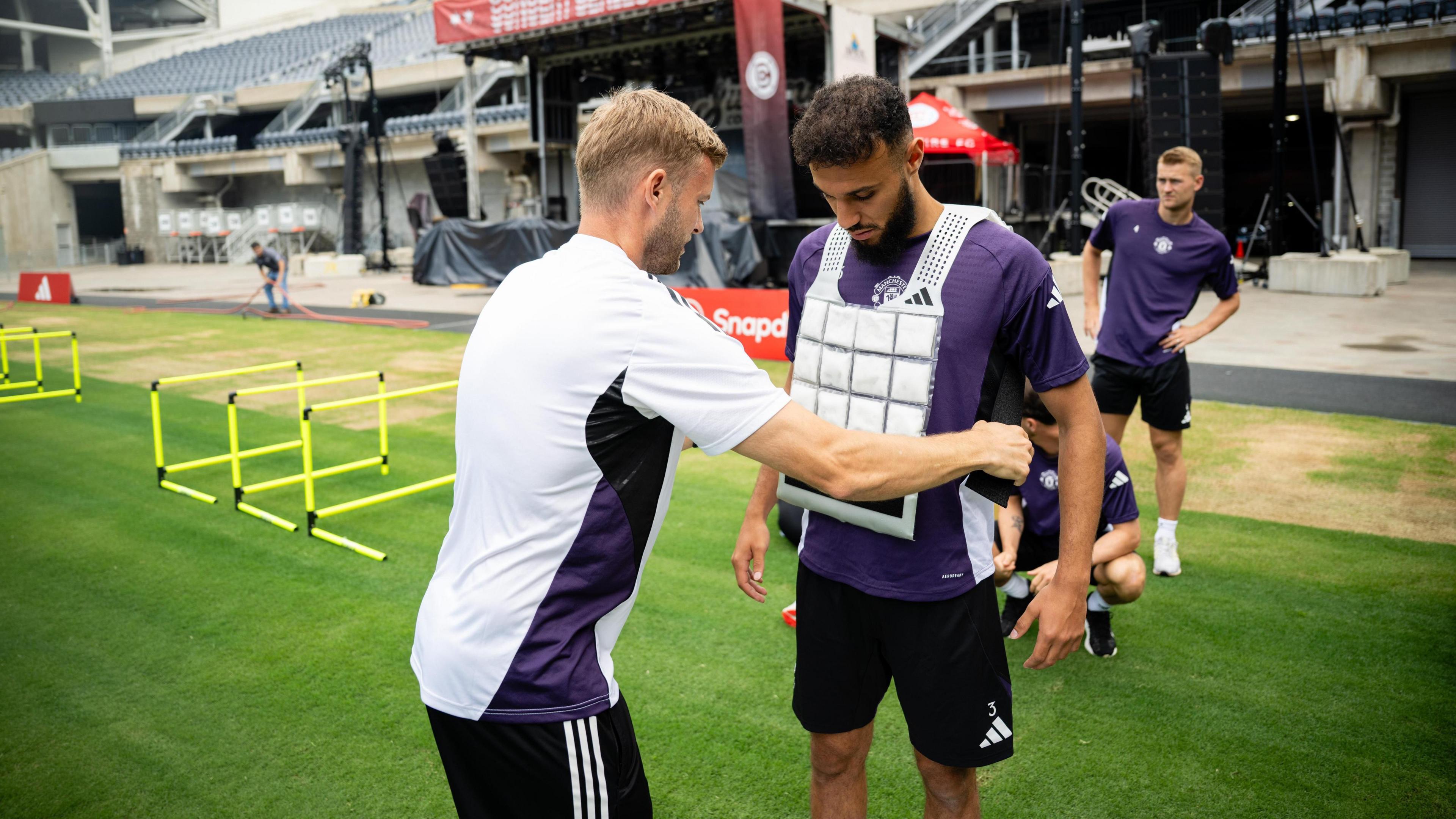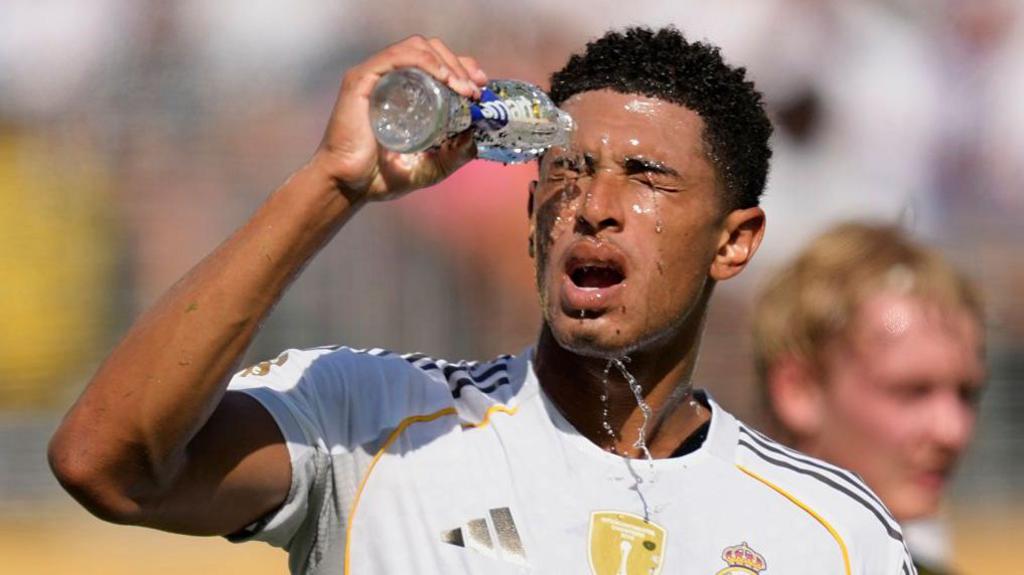What are cooling jackets and how do they work?
- Published
Manchester United are using cooling jackets in a bid to help their players deal with the heat during their Premier League Super Series campaign in the United States.
Cooling jackets have been around in various forms as early as the 1950s and 60s, first used by the military and have since been used in a range of sports including Formula 1, cycling, tennis and rowing.
They are designed to reduce an athlete's core and skin temperature, with studies showing it can lead to an improvement in endurance, performance and limit the risks of heat stroke and heat exhaustion.
The type currently used by United are from a range by kit manufacturers Adidas that were launched earlier this year.
Those cooling jackets are being worn by players following warm-ups and at half-time of their three matches in the United States.
Players at the 2025 Club World Cup this summer experienced extreme heat in a number of matches. Multiple cooling breaks were taken, as well as some stadiums installing large mist fans on the sidelines.
Borussia Dortmund's substitutes also spent the first half of their group stage match against Mamelodi Sundowns sat in the changing room to avoid the heat.
Get in touch
Send us your questions
How are cooling jackets used and do they actually work?

Manchester United's Noussair Mazraoui getting a cooling jacket put on in training during the Premier League Summer Series
The earliest models of cooling jackets used by the army required a power supply to circulate cold water around the body, but technological advancements since then mean this is no longer the case.
When Adidas released their Climacool System technology earlier this year, it consisted of an insulated jacket that goes over the top of a cooling vest.
"For the same exercise intensity in a hot compared to a cooler condition, the heart rate's higher, the body temperature's higher. That can lead to things like heat stroke, or even maybe even worse, heat exhaustion," said Dr Chris Tyler, a reader in environmental physiology from the University of Roehampton.
"What the vest will claim to do is reduce all of that. So they will lower the body temperature, lower the heart rate and lower the strain."
The use of the vest is key into its effectiveness. There is a major difference between how someone's body feels to them and their actual body temperature.
They need to be worn for a sustained period and cover as much of the body as possible.
This allows more time for the body to effectively cool down quicker, reducing the risks attached to being too hot and also helping athletes to run quicker and for longer with less strain.
A difference maker for the 2026 World Cup?

During the 2025 Club World Cup, players regularly dowsed themselves in water
Given the conditions during the Club World Cup in what was unofficially a warm-up for the 2026 men's World Cup, it gives a good indication of what can be expected during next summer's tournament across the United States, Canada and Mexico.
Compared to the 32-team Club World Cup, there will be 48 nations at the World Cup. This will mean more daytime matches and additional challenges to players when it comes to dealing with the weather.
"Certainly some sort of proactive cooling intervention," Dr Tyler replied when asked if cooling vests will be a necessity at the Club World Cup.
"The best way to avoid it is to not play in those conditions, but we know that's not going to happen for lots of reasons.
"There could be some proactive scheduling. I've seen people talk about very early kick-offs or very late kick-offs, and they do that in La Liga - that tends to kick off very late, for example.
"We saw players struggling this summer, there's no reason to think we won't see them struggling next summer as the teams will be more likely to be adopting cooling strategies to try and combat that."
Dr Tyler added that he expects cooling jackets, or at least some form of cooling equipment will be used widespread across the World Cup.
"Definitely. All the teams that can, will. Those teams that have huge support behind them certainly will and teams are already preparing for next year's World Cup with an eye on the heat," he explained.
"Some of those might be off the shelf measures, some of them might be bespoke measures.
"The better teams generally are impacted less by the heat because they can control the tempo, they can make the opponent run, those sorts of things.
"I think every national teams should be able to have the resources to have something and not to sort of be overlooked."
Cooling jackets in Formula One
In March, Adidas released their Climacool System, consisting of an insulated jacket and a specially created cooling vest.
F1 team Mercedes used the jackets for any races in which hot weather would affect the performance of their drivers.
The manufacturer say that in hot conditions, drivers can experience temperatures between 55C and 60C which leads to a weight loss of 4.2kg (9.3 pounds) just in sweat during a single race.
F1 drivers tend to immerse themselves in water ahead of a race to cool their whole body down in advance to their race preparations.
"Typically, [F1 drivers] will do that an hour before the race," Dr Tyler said.
"What they're doing is when they put the vests on that's largely perceptual. What they're trying to do is as much as possible is feel cooler for as long as possible which is what those vests are doing.
"Next year, the FIA are going to really introduce various in-car cooling suits when the races are hot enough. Now that's going to be very similar to [what] the military used to use.
"The drivers will be sitting, so they won't be doing as much activity as if say you were running, but they're going to sitting on an engine, they're going to be sitting on a hot track.
"I have my doubts that they're going to be able to extract enough heat to actually lower the strain of the drivers, but they're certainly going to make the drivers feel a bit cooler.
"It also provides a nice platform for all of their companies and sponsors to have another place to have their badge which is something that the Formula One teams have suddenly cottoned onto."
This article is the latest from BBC Sport's Ask Me Anything team.
What is Ask Me Anything?
Ask Me Anything is a service dedicated to answering your questions.
We want to reward your time by telling you things you do not know and reminding you of things you do.
The team will find out everything you need to know and be able to call upon a network of contacts including our experts and pundits.
We will be answering your questions from the heart of the BBC Sport newsroom, and going behind the scenes at some of the world's biggest sporting events.
Our coverage will span the BBC Sport website, app, social media and YouTube accounts, plus BBC TV and radio.